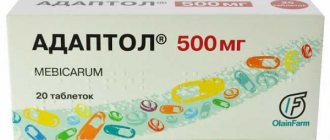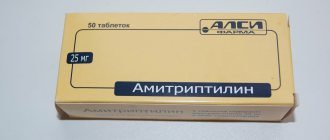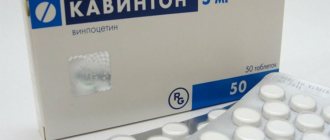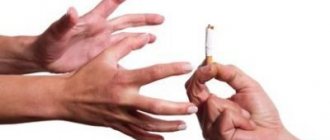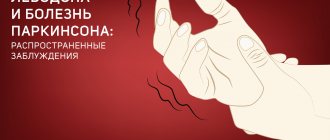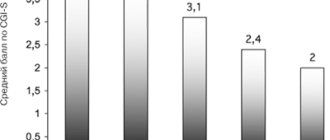Moderate poisoning
An overdose of Phenazepam in this form is accompanied by a more pronounced clinical picture:
- impaired swallowing reflex and tongue retraction
- severe constriction of the pupils and lack of reaction to light
- suppression of the cough reflex
- deterioration in muscle contractility
- lack of closure of the palpebral fissure in response to exposure to the cornea
A superficial coma is possible, which is accompanied by loss of consciousness and erratic movements in response to painful stimuli. In this case, it is impossible to wake the patient. In this condition, vomiting is possible, which is life-threatening.
Severe form
Symptoms of a severe overdose of Phenazepam:
- lack of reflexes
- agony
- dilated pupils
- reduction in blood pressure to critical levels
- respiratory depression
- increased heart rate
- critical decrease in body temperature
- deep coma
In the absence of intensive care, death occurs from Phenazepam.
Chronic form of poisoning
This form is possible with regular, slight excess of the dosage recommended by the doctor. In this case, the patient encounters the following symptoms:
- limb tremors
- feeling of unreasonable anxiety
- weakness
- fatigue
- drowsiness
- migraine headaches
- increased excitability
In severe cases, seizures and hallucinations are possible. The chronic form of intoxication is dangerous and requires treatment.
What is Phenazepam
The international name of the drug is bromodihydrochlorophenylbenzodiazepine, it has a strong muscle relaxant effect.
Phenazepam has a hypnotic, sedative, anxiolytic (relieves anxiety) and anticonvulsant effect. A highly active tranquilizer is available in the form of white tablets with a chamfer or a solution for intravenous or intramuscular administration, with a capacity of 1 ml. You can buy the drug at a pharmacy with a doctor's prescription.
The following components can be found in Phenazepam:
- active ingredient – bromodihydrochlorophenylbenzodiazepine;
- calcium stearate;
- lactose (shelf sugar);
- talc;
- potato starch;
- Kollidon 25 (povidone).
Phenazepam successfully combats depressive and hysterical conditions, relieves neuroses and insomnia. It promotes nervous system calm and relaxation, not only of nerves, but also of muscle tissue.
In addition, the drug copes well with pathologies such as epilepsy. convulsive attacks of neurotic origin, for the treatment of pathological conditions in military field medicine.
Purpose
Phenazepam has a fairly wide range of uses. It is prescribed for:
- Sleep disorders;
- Neuroses and psychopathic conditions, which are characterized by feelings of emotional irritability, anxiety and fear, emotional instability and sudden mood swings;
- Hypochondria syndrome;
- Autonomic dysfunctions;
- Reactive psychosis;
- Panic attacks;
- Tics and dyskinesia;
- Prevention of phobias of various etiologies;
- With nervous system instability;
- Muscle rigidity and increased tone;
- Withdrawal syndrome of alcohol origin, but during a hangover you cannot take Phenazepam, since alcohol is still present in the body.
In essence, anxiolytic drugs like Phenazepam are psychotropic drugs that reduce the severity or eliminate feelings of fear and anxiety, restlessness and emotional tension. Phenazepam has the following effects:
- anticonvulsant;
- sedative;
- sleeping pills;
- anxiolytic;
- muscle relaxant;
- amnestic, etc.
Overdose symptoms
An overdose of any drug is dangerous, so they must be taken carefully, in full accordance with the prescriptions of the attending physician. Phenazepam with alcohol is very dangerous, but by itself it should be taken only in the dosage prescribed by a specialist
An overdose of phenozepam may be small, but even in this case, disturbances in the activity of the central nervous system will be observed. A severe overdose is life-threatening; there is a suppression of heart function and respiratory activity. In severe forms, an overdose of phenozepam causes symptoms such as pronounced drowsiness, in which the patient cannot be awakened, severe tremor, prolonged confusion, decreased reflex functions, shortness of breath, nystagmus, dysarthia, stupor, severe difficulty breathing, coma. If you combine large doses of medication with alcohol, you get a so-called lethal dose.
In case of an overdose, you must immediately call an ambulance until a doctor arrives, and constantly monitor the victim’s condition. If he is conscious, then he will have to organize gastric lavage. To do this, you need to use a large amount of water (about three to five liters) or a solution of sodium sulfate or sodium chloride. After this, the victim should be given activated charcoal, which will help delay the absorption of the drug taken into the walls of the intestines and stomach. You can use a laxative to speed up the elimination of toxins from your body. The patient should not be allowed to sleep; if breathing stops, artificial respiration must be performed.
Treatment of an overdose is possible only in a hospital setting; you should not try to do it at home. In the hospital, the effect of the drug on smooth muscles is immediately weakened, for which drugs based on strychnine are used. They are usually prescribed intramuscularly, two to three times a day. These are injectable 0.1% solutions of strychnine nitrate or solutions of corazol; anexat, a solution of sodium chloride 0.2 milligrams 0.9%, a solution of glucose 5% can also be used. After this, symptomatic treatment is prescribed. Consumption of alcoholic beverages is strictly prohibited.
Phenazepam is a fairly powerful psychotropic drug belonging to the benzodiazepine series. The effect of taking it is as follows: a decrease in spontaneous motor activity, an antipsychotic, tranquilizing, hypnotic effect. It is prescribed for reactive psychoses, obsession, insomnia, for neurotic, psychopathological, neurosis-like conditions, for treatment of alcoholism. But you should take phenazepam only as prescribed, without exceeding the dose. Under no circumstances should an overdose be allowed, as the amount of the drug can be fatal.
Consequences
An overdose of the drug is dangerous, as it poses a danger to human life and health. The consequences of an overdose of Phenazepam in large volumes can be irreversible - death, and also difficult to reversible - coma. In addition, the medication can cause complications that require additional treatment. This:
- pneumonia
- inflammatory pathologies of the genitourinary system
- severe mental disorders
- liver pathologies
- renal dysfunction
- disturbance of brain activity and central nervous system functions
- gastrointestinal pathologies
How to remove Phenazepam from the body quickly
The most effective way to quickly get rid of the remnants of the drug is to drink plenty of fluids to enhance the diuretic properties of the body. You can also use means that provoke the removal of fluid from the body.
Diuretics
To do this, it is better to use herbal preparations, decoctions of medicinal herbs and plants with a diuretic effect:
- linen;
- Linden;
- cinnamon;
- birch;
- thyme;
- oregano;
- sage;
- Melissa;
- St. John's wort;
- calendula;
- motherwort;
- valerian;
- milk thistle;
- horsetail;
- juniper.
Moreover, you should strictly follow the instructions attached to ready-made preparations or herbal preparations. If any side effects occur, it is better to abandon this method. Instead, you can try more tasty methods, in particular, including foods with a similar effect in your diet.
Diuretic fruits:
- mango;
- pears;
- persimmon;
- pomegranate;
- apples.
Diuretic vegetables:
- cucumbers;
- carrot;
- pumpkin juice;
- tomatoes.
Diuretic berries:
- watermelon;
- viburnum;
- Rowan;
- cranberry;
- blackberry;
- cowberry;
- gooseberry.
Diuretic cocktail:
To speed up the elimination of medicinal metabolites, you can use one effective method that has been known for a long time. To prepare the cocktail, mix viburnum and rowan juice (200 ml each) and lemon juice (100 ml). Add liquid natural honey (100 g) and phytolysin (vegetable mixture) in the amount of 3 tbsp. l. Take 20-25 ml three times a day after meals.
Gastric lavage
If no more than 4 hours have passed since the last time you took Phenozepam, you can cleanse the body of its presence by gastric lavage. To do this, take a large amount of warm, slightly salted water and induce artificial vomiting. After cleansing the stomach, it is advisable to take sorbents and perform an enema so that the drug metabolites leave the intestines.
Herbal cleansing
This method is quite popular and effective. By choosing the most suitable recipe for yourself, you can significantly speed up the process of cleansing the body of drug residues. Herbal decoctions improve intestinal motility and increase urination.
In this case, cleansing occurs naturally, and the tranquilizer metabolites leave the body along with urine and feces. Experts advise using one of the following recipes:
Oatmeal broth. Mix oats, chopped chicory root, hawthorn, rowan and rose hips (15 g each). Pour the mixture with clean water (500 ml) and boil for 5-7 minutes. Then wrap the container with a thick cloth and leave to infuse for 2-3 hours. Take 5-6 times a day, 100 ml.
Flax seeds. Mix flaxseeds (100-150 g) with water (150 ml). Bring this mixture to a boil and cook slowly until the mixture thickens to the consistency of jelly. When cooking, the drug must be stirred constantly. Then strain and take all the medicine orally within an hour.
Nettle. Nettle infusion will also help cleanse the body. To prepare it, crushed dry leaves of the plant (50 g) should be steamed with boiling water (1.5-2 l). Leave the mixture for 1-2 hours and drink throughout the day.
Be sure to remember that any method of accelerating the removal of drug residues from the body can potentially pose a health threat! After all, these drugs promote the removal from internal organs of minerals, proteins and vitamins necessary for life.
Therefore, at the same time as cleansing the body, diversify your diet, making it richer in proteins and vitamins. And do not forget to take a course of multivitamins after the procedures to restore the level of necessary micro- and macroelements in the body.
Side effects of Phenazepam
The negative consequences of taking a medication can be associated not only with its effect on the nervous system, but also with malfunctions of other internal organs. Most often, the situation is limited to a decrease in physical activity, drowsiness, lethargy, and a feeling of constant fatigue.
The summary of the drug indicates the possibility of developing the following adverse reactions:
decreased functionality of the central nervous system in the form of problems with concentration, dizziness, headaches, speech depression, coordination disorders;
You will learn about other reasons that can cause headaches in this article.
- dementia and senile dementia in people over 65 years of age;
- increased manifestation of the symptoms that the treatment was aimed at combating. Very rarely this takes the form of insomnia, hallucinations, aggression, muscle spasms;
- decreased libido in both sexes, erection problems in men;
- a decrease in blood pressure to pathological levels with initially low numbers;
- deterioration of the liver and kidneys due to the toxic effects of the main component on these organs;
- changes in blood composition;
- dyspeptic disorders in the form of dry mouth, loss of appetite, constipation, diarrhea, nausea;
- allergic reactions of various types and severity;
- drug addiction type;
- weight loss;
- heart rhythm disturbances.
Some consequences develop immediately after taking the product, others become the result of course therapy. The decision on the advisability of further use of the drug is made by the doctor based on signs of positive dynamics of the main treatment and the severity of adverse reactions.
Consequences of overdose
Intoxication with Phenazepam poses a serious threat to the health and life of the patient. Drug poisoning often triggers a mechanism for further complications in the form of other diseases. The most dangerous are:
- Respiratory damage
- Inflammatory processes in the genitourinary system
- Mental changes
- Pathologies of the liver and kidneys
- Serious damage to brain cells
- Gastrointestinal diseases
- When immobile, bedsores occur.
The occurrence of any pathology after tranquilizer intoxication will require serious treatment.
Phenazepam is a serious drug for eliminating complex conditions, and therefore must be treated with caution. Any non-compliance with treatment conditions can lead to death of the patient. Therefore, it is very important to take the drug in the prescribed amount, not to exceed it and to monitor the peculiarities of combination with other medications.
Alcohol compatibility
Previously, narcologists tried to treat people for alcoholism with the help of the “folk” tranquilizer “Phenazepam”. Treatment began after a couple of days so that ethanol was completely removed from the body, since alcohol and this medicine are not compatible. It is absolutely impossible to drink them together, as this is simply a lethal dose for the human body.
After an alcoholic binge, a high level of ethanol is observed in the blood system. If you take Phenazepam at this time, it will have a stronger effect on the nervous system.
Taking the drug after alcohol can cause phenazepamine sleep, which will adversely affect your health. Severe intoxication and vomiting may begin. If a drunk person sleeps on his back, then in some cases cardiac arrest may occur or he will choke on leftover food.
Taking alcoholic beverages together with medication can only emphasize the harm of Phenazepam. For example this:
- increasing the aggressive state of an unhealthy person;
- with alcoholic fog, consciousness becomes even more confused;
- manifestations of a suicidal nature;
- a person’s mood deteriorates, he is visited by hallucinations and fear;
- memory deteriorates;
- in space he becomes disoriented,
- after taking the drug and alcohol, you lose control over your actions and words and other bad moments.
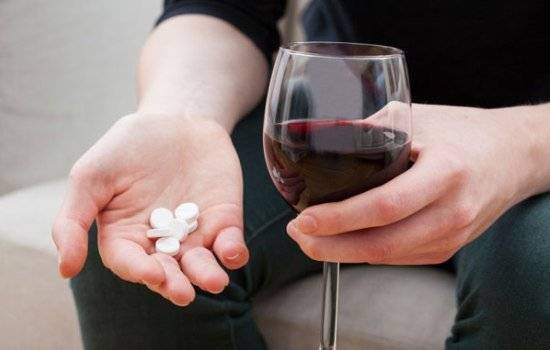
Phenazepam - benefits and harms
This drug is capable of acting on the central nervous system and other human organs. Treatment with it is carried out under the supervision of a doctor. Due to the fact that the drug belongs to the narcotic group, it can cause hallucinations, tremors and muscle spasms.
What is the harm of the drug?
- Improper use may cause poisoning.
- The following symptoms may appear: weakness, hallucinations, drowsiness, dizziness, absent-mindedness, lack of coordination, motor and mental passivity, depression.
- While taking the drug, it is prohibited to engage in activities that require increased attention and, if careless, can cause harm to others.
- Digestion is disrupted.
- Causes an allergic reaction.
- Drinking alcohol during treatment is strictly prohibited.
Benefits of the drug
The drug is used to treat the following conditions:
- Increased irritability.
- Psychoses of various complexities.
- Insomnia.
- Emotional stress.
- Epilepsy.
- Muscle stiffness.
- Autonomic dysfunctions.
- Hyperkinesis.
It is widely used in the field of neurology.
Phenazepam and alcohol
The simultaneous use of medicine with alcohol is dangerous for human health and life, regardless of the volume of the components. Their combination increases each other's toxicity, increases the risk of adverse reactions, and leads to inhibition of the activity of vital centers of the central nervous system. Even in minimal doses, such a complex of substances causes dizziness, increased fear, sweating, and confusion. In some cases, people experience hallucinations and become suicidal.
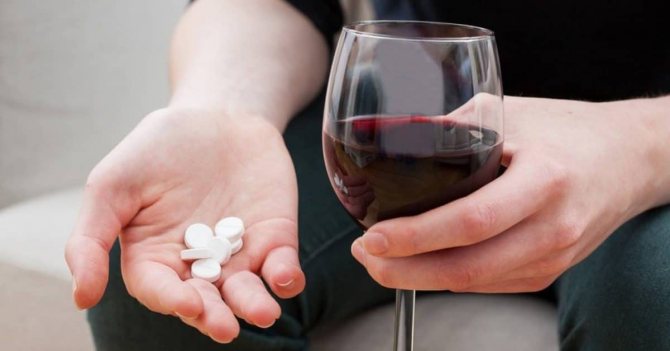
It is strictly forbidden to use the drug to fall asleep against the background of alcohol intoxication. Drug-induced sleep can lead to complications such as choking on vomit, retrograde amnesia, and involuntary emptying of the bladder and bowels. Against this background, there is a high risk of respiratory arrest or an attack of suffocation. Even if the victim receives timely medical care, there is a possibility of irreversible changes in his brain.
Analogs
All benzodiazepines are CNS depressants, causing disturbances in psychophysical status to one degree or another. With long-term use they cause dependence. The pharmacological group includes the following substances:
- triazolam;
- clonazepam;
- diazepam;
- lorazepam;
- nitrazepam;
- gidazepam;
- flunitrazepam.
In terms of clinical action, barbiturates are most similar to benzodiazepines. They have a greater degree of hypnotic and sedative properties. Long-term use leads to addiction and multiple organ failure, including brain damage.
The most dangerous CNS depressants are opioids, such as heroin. These substances are exclusively illegal. Chronic intoxication is accompanied by severe social degradation, disability, and mental disorders. The risk of contracting viral hepatitis and HIV increases.
Just as with the abuse of barbiturates and other sleeping pills, a unique personality defect is formed, reminiscent of an organic one with a change in the entire structure of the personality. Patients experience intellectual-mnestic disorders. The face becomes mask-like, facial expressions are poor. Speech and all movements are slowed down. Lethargy increases. Callousness, rudeness, selfishness, and cruelty towards loved ones are observed. Moral and ethical standards of behavior are violated. Performance drops sharply. Patients become unfit for work involving mental and physical stress.
Tiganov A.S. (ed.) ‹‹Exogenous mental disorders›› Substance abuse caused by abuse of tranquilizers
Causes and signs of overdose
Why is it possible to develop a drug overdose? There are a number of factors that contribute to the occurrence of poisoning.
Factors:
- Self-treatment with medication, incorrect dosage calculation.
- In children, poisoning occurs as a result of consuming tablets that are in places accessible to them.
- Taking a large dosage for the purpose of suicide,
- Using the drug simultaneously with alcoholic beverages, other psychotropic substances, and drugs.
An overdose is characterized by the presence of certain signs that it is recommended to pay attention to. The first symptoms are observed twenty minutes after taking phenazepam
In mild forms of overdose, symptoms appear after a longer period of time.
Symptoms:
- Desire to sleep
- Confused mind
- Low pressure,
- Irregularities in heart rhythm, heartbeat slows down
- Intestinal dysfunction - constipation or diarrhea,
- Urinary retention or involuntary loss of urine,
- Speech dysfunction
- The presence of visual and auditory hallucinations,
- Increased flow of saliva,
- Pallor of the skin, cyanosis,
- Respiratory disorder
- Decreased reflexes
- Lack of consciousness.
How many hours does it take for death from phenazepam to develop? If you take a large dose and there is no help, a similar condition can occur after forty minutes.
Indications for use
The instructions for phenazepam provide the following contraindications for taking the drug:
- depression;
- glaucoma;
- pronounced disturbances in the functioning of body organs such as kidneys, liver;
- strong and weak poisoning with tranquilizers;
- poisoning caused by antipsychotic drugs, that is, neuroleptics;
- poisoning with sleeping pills;
- taking drugs.
Why can’t the drug be used during a hangover?
The combination of alcohol and phenazepam is two opposites. Despite the fact that this particular drug is prescribed for the treatment of acute alcohol withdrawal, phenazepam cannot be used during a hangover, when the alcohol content in the body is still quite high. You should not take phenazepam at this time and for the following reasons:
- When there is a dose of alcohol in the blood, the drug only enhances its effect on the central nervous system. Such situations are especially dangerous when there is a high concentration of ethanol in the body. When taking the drug, a so-called phenazepam sleep may occur, which, when alcohol intoxication of the whole body is observed, greatly increases the likelihood of such complications of drunken sleep as vomiting when lying down, respiratory depression, crash syndrome, cardiac arrest, retrograde amnesia, involuntary defecation , urination, etc., that is, phenazepam acts as a kind of amplifier of such negative manifestations.
- Phenazepam causes a rapid addictive effect. And when drinking alcohol, this is not only a fleeting addiction, but also dependence with the development of a severe form of abstinence. Any instruction warns that taking a drug with alcohol in the blood can cause symptoms such as epileptic seizures, hallucinations, anxiety, fits of rage, inappropriate behavior, and nightmares.
You should not drink this drug even during a hangover, when the alcohol concentration is sufficient to cause not only these symptoms, but also more severe ones.
- The combination of phenazepam and alcoholism is categorically unacceptable for such groups of patients who experience changes in the central nervous system. These are elderly people, adolescents taking psychoactive drugs, users of cannabinoids, patients with hereditary changes in metabolism. In this case, the combination of phenazepam - alcohol and other MDD agonist drugs cause such paradoxical reactions as inappropriate behavior, attacks of mental changes, hallucinations, etc., all this against the background of rapid addiction.
- The combination of phenazepam and alcohol during a hangover causes the so-called aftereffect syndrome, that is, a severe decrease in performance, irritability, and muscle weakness. All this narrows the possibility of treating any, including acute, cases of hangover.
Phenazepam tablets are strictly contraindicated:
- For mental illnesses, because the body’s reaction to the drug is unpredictable;
- When using drugs or alcohol - this is the answer to those who are interested in whether Phenazepam can be taken with alcohol;
- Pregnancy;
- Renal and hepatic pathological conditions;
- Lung failure;
- Heart pathologies;
- Coma or shock;
- Up to 18 years of age;
- For glaucoma;
- Intoxication with antipsychotic or tranquilizer drugs.
Here is a basic list of contraindications:
- state of shock;
- high sensitivity to the drug;
- coma;
- myasthenia gravis;
- glaucoma;
- poisoning with sleeping pills, narcotic analgesics, alcohol;
- respiratory failure;
- pregnancy;
- depression;
- not recommended for use by children and adolescents under 18 years of age.
“Side effects” during the functioning of the hematopoietic organs:
- leukopenia;
- agranulocytosis develops;
- thrombocytopenia;
- neutropenia;
- anemia.
The digestive system can cause the following problems:
- heartburn;
- dry mouth;
- vomit;
- constipation or diarrhea;
- loss of appetite;
- jaundice;
- liver problems.
- drug dependence;
- addiction;
- worsening blood pressure;
- weight loss;
- tachycardia.
Overdose, addiction, harm to the body
For outpatient treatment (at home), Phenazepam is taken 0.25–0.5 mg 2–3 times a day. Under the supervision of a doctor in a hospital, the dosage can be increased to 5–10 mg per day. Such measures are taken for effect as a last resort - for example, in the treatment of epilepsy.
The maximum permissible daily dose of Phenazepam for an adult is 0.01 g.
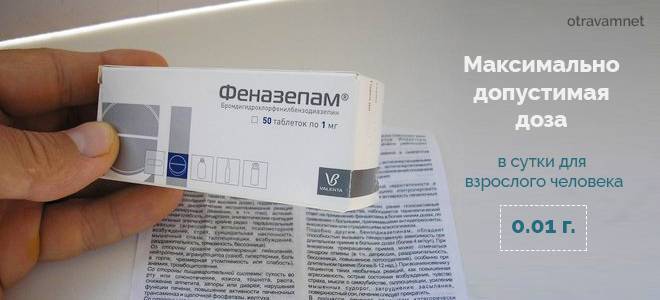
Overdose is expressed:
- excessive sleepiness;
- prolonged confusion;
- decreased reflexes;
- long-term dysarthria;
- muscle tremors;
- bradycardia (low heart rate, pulse about 30–50 beats per minute);
- shortness of breath, disruption of the respiratory cycle;
- decreased blood pressure;
- coma.
Taking Phenazepam, even in permitted doses, may be accompanied by side effects:
- regular feeling of fatigue;
- deterioration of concentration, attention and memory;
- partial or complete disorientation;
- difficulty in motor and mental reactions;
- headaches;
- increased depression;
- asthenic syndrome;
- dysarthria (speech disorder);
- dizziness;
- ataxia (motility disorder, expressed in inconsistency of movements of different muscle groups);
- unbalanced gait;
- confusion;
- euphoric state.
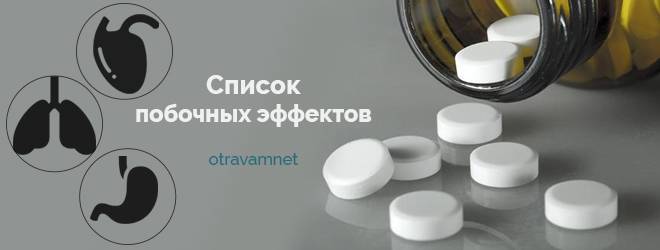
Disturbances in the functioning of the cardiovascular system and changes in the biochemical composition of the blood are often observed. Long-term use of Phenazepam can provoke:
- leukopenia and agronulocytosis - a decrease in the level of leukocytes in the blood;
- thrombocytopenia – decreased platelet count, deterioration of coagulation;
- neutropenia – a decrease in the number of neutrophils, reducing the body’s resistance to bacteria and fungi;
- tachycardia – increased heart rate;
- anemia – decreased levels of hemoglobin and red blood cells.
The following reactions are observed from the digestive system:
- dryness of the mucous membranes of the oral cavity;
- heartburn;
- nausea, vomiting;
- stool disorders (constipation or vice versa, diarrhea);
- loss of appetite;
- jaundice;
- destabilization of the liver.
With long-term use of this tranquilizer (more than two weeks), patients become dependent. Without Phenazepam, they feel a deterioration in their condition, inexplicable anxiety and panic. The initial dosages of Phenazepam have to be increased.
If treatment is abruptly stopped, withdrawal syndrome occurs. Often, patients who have tried to cope with alcohol addiction fall into a new trap from which they can no longer get out on their own. Destabilization of the mental state caused by side effects can lead them to rash actions.
After the first symptoms of addiction to Phenazepam appear, you should contact your doctor to replace the therapy with a safer analogue.
Contraindications

Phenazepam is prohibited from use in the following cases:
- glaucoma;
- state of shock;
- pregnancy;
- breastfeeding period;
- chronic and acute renal dysfunction;
- myasthenia gravis;
- severe liver damage;
- myasthenia gravis (muscle weakness);
- individual intolerance to components.
If there is a need to increase the dosage of Phenazepam due to the body’s addiction, it must be agreed with the attending physician. Increasing the dose on your own is unacceptable.
Phenazepam should not be combined with alcohol, analgesics with narcotic properties, or hypnotics. It is also not recommended for children and adolescents under 18 years of age.
What is the lethal dose of Phenazepam
The amount of the drug that can lead to death depends on a number of factors, including the general condition of the patient, the presence of chronic pathologies, and the fact of addiction. The fact of drinking alcohol and smoking also matters. This medicine and strong drinks are incompatible.
The instructions for the drug state that the maximum permissible daily dose is 10 mg. Exceeding this value can lead to undesirable consequences: severe poisoning can occur, which can provoke severe complications, including death.
READ Aspirin overdose
For adult patients, the dose at which you can die is taking 0.5 mg of the drug per 1 kg of body weight. For children – 0.25 mg/1 kg.
Clinical picture of phenazepam poisoning
Phenazepam is a medicine that has the following properties: anticonvulsant (used in the treatment of epilepsy, alcoholic delirium), sedative, hypnotic (for insomnia caused by unmotivated anxiety), muscle relaxant (for muscle spasms). The drug is addictive; for the same effect, you need to increase the dose. At home, without medical supervision, an overdose can occur. The clinical picture develops in stages:
- Initial manifestations are similar to alcohol intoxication. After taking a high dose of medication, the first symptoms appear within 30 minutes. The patient is in a state similar to intoxication: he is incredibly happy, feels strong, fearless. The patient's speech is slurred and unclear. Coordination of movements is impaired. Symptoms of euphoria are replaced by drowsiness and apathy. The patient falls into a deep sleep. An objective examination reveals bradycardia (heart rate less than 60), increased salivation, the reaction of the pupils is lively, they are narrowed.
- In the second stage, the person falls into stupor - a superficial coma. The patient is unconscious. The main difference from a deep coma is that the reaction to pain is preserved. The pupils are constricted. There is vomiting, which threatens lung aspiration. Muscle reflexes and tone are reduced.
- Without medical help, the second stage quickly progresses to the third. The patient is in a deep coma and does not respond to external stimuli. Main symptoms: thread-like pulse, bradypnea (rare breathing), all reflexes are completely turned off. Impaired kidney and liver function occurs. Only correct and effective emergency measures can help the patient. The absence of medical intervention threatens to stop breathing, cardiac activity, and brain function.
- The fourth stage occurs only after adequate and timely treatment. It's called awakening. The person comes out of a coma, and lost systemic functions are gradually restored.
The presence of medications at home poses a direct threat to the child’s health. Often young children accidentally take pills out of curiosity. Grandmother, grandfather, and mother were prescribed the drug, the child was interested in the open cabinet, and trouble could not be avoided.
There are three degrees of phenazepam overdose:
- Easy. A small dose of the drug does not suppress higher nervous activity and is manifested by minor behavioral disturbances. The patient is sleeping. Decreased tendon reflexes, muscle hypotonia, and uncoordinated movements are noted.
- Moderate degree is an intermediate state between mild manifestations of poisoning and coma. The patient has impaired swallowing and cough reflex. On objective examination, the pupils are constricted and do not respond to light stimuli. Severe degree is characterized by agony, complete loss of vital functions. The patient exhibits pathological types of breathing, weak pulse, abnormally dilated pupils, decreased body temperature and blood pressure.
- Chronic poisoning is distinguished separately. The patient independently increases the dosage or number of phenazepam doses. First, trembling of the limbs, unmotivated weakness, attacks of nausea, depressive, anxious states, and insomnia appear. Over time, the clinical picture is supplemented by complaints of vomiting, epigastric pain, hallucinations, and convulsions.
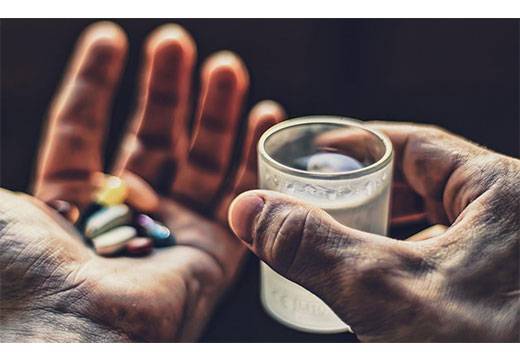
How to help someone who has been poisoned yourself?
Before you begin to provide first aid, you must call doctors to the scene of the incident. While experts are getting to the victim, people around him should:
- Bring him to consciousness and induce vomiting. Reversing this algorithm is strictly prohibited. If the patient is unconscious at the time of artificial stimulation of the gag reflex, he can easily choke on his own vomit. To speed up the process of removing vomit, you will need to create a saline solution in an amount of at least one and a half liters of liquid. The patient must drink all the liquid in a short period of time, even after “I don’t want to.” After vomiting, the procedure is repeated until the clear water leaves (usually 2-3 times is enough).
- Give sorbents. It is absolutely not necessary to give the patient only activated charcoal. Its white counterpart is considered even more effective, since it does not wash various beneficial substances out of the body.
- Monitor the current status. If the patient is unconscious, it is better to revive him.
It is important to understand that such intoxications cause irreparable damage to the body, regardless of the age of the victim. The problem is that any drug poisoning always means very rapid absorption of the active substance into the blood. Only the introduction of an antidote and symptomatic therapy can relieve a person of pain.
